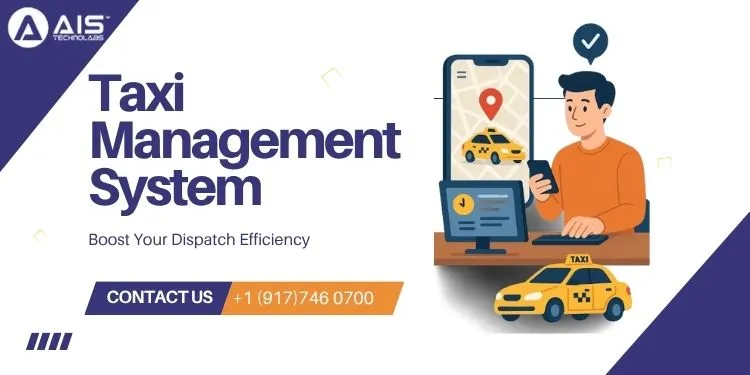Table of Content
(500 views)

Introduction
In today's world, efficiency is the word—especially in the taxi industry where punctuality makes or unhappiness breaks customer satisfaction and company success. Managing a fleet of taxis and ensuring that customers get prompt pickups requires a seamless dispatch system. Unfortunately, traditional taxi dispatch operations falter due to manual processes and communication breakdowns. Except for a Taxi Management System (TMS) that can convert such weaknesses into strengths, dispatch efficiency can be significantly improved and overall performance enhanced.
Here, we will learn how a Taxi Management System will turn your dispatch process into one that is faster, smarter, and more reliable taxi services.
Understanding the Taxi Dispatch Challenge
To gauge the solution, let us first understand the common issues taxi companies face with managing the dispatch operations. Dispatching is assigning the right driver to the right customer at the right time, something easy to say but in reality rather involved.
Process bookmaning tends to bog down dispatchers, who must juggle calls, monitor driver locations via word of mouth, and manually allocate rides. Customers end up waiting longer, while drivers have unbalanced workloads.
In addition, breakdowns in dispatch-driver communication can result in confusion, delays, and lost opportunity to optimize routes. With no real-time location tracking, it is difficult to allocate rides on the basis of driver proximity or traffic flow, and therefore suboptimal route planning ensues.
This makes taxi companies lose customers to others providing faster, more reliable services. That's where a Taxi Management System comes into the picture.
What is a Taxi Management System?
A Taxi Management System is a complete software system that is used to automate and optimize taxi firms, from reservations and dispatch to payment and driver administration.
With as advanced features as real-time GPS tracking, computer-aided dispatch software, and integrated communications tools, a TMS reduces human intervention to an absolute minimum. Not only does this speed up dispatch, but also boosts accuracy and clarity for all involved.
How a Taxi Management System Enhances Dispatch Efficiency
Now that we have an idea of the problems and what a TMS is, let's talk about how it specifically increases dispatch efficiency.
1. Automated Dispatching Locates Drivers Faster
One of the most significant improvements a Taxi Management System offers is automated dispatch. Instead of having dispatchers manually assign rides, the system automatically assigns arriving ride requests to the nearest available driver.
Doing this minimizes booking-to-assignment latency and wait times significantly. It also removes human error, such as assigning more than one ride to one driver or not being able to locate nearby drivers.
2. Dynamic Routing with Real-Time GPS Tracking
Through real-time GPS tracking, dispatchers—and the system—can monitor driver locations and traffic trends in real-time. This allows the system to continuously route drivers for faster pick-ups and drop-offs and avoid traffic congestion.
Customers appreciate more accurate ETAs, and drivers are able to finish more trips faster, boosting overall fleet productivity.
3. Centralized Communication Keeps Everyone on the Same Page
Dispatch operations rely heavily on communication. A Taxi Management System includes notification and messaging features that create a real-time interface between dispatchers, drivers, and riders.
For Example, Drivers receive instant notifications of new pickup jobs, updates, or cancellations by the application itself. Customers are given real-time notifications about driver arrival times and are able to send through any special requests in no time.
With centralized communication, lost messages and misunderstandings decrease, and the operations are smother.
4. Insights Based on Data Refine Dispatch Techniques
A Taxi Management System, as time goes by, acquires valuable information on patterns of rides, busy hours, driving behavior of drivers, and reviews from customers. Taxi businesses utilize such information to take appropriate decisions to optimize dispatch strategies.
For instance, prior knowledge of high-demand hours enables managers to deploy more drivers to such hours in turn. Performance data indicates improved performers and poor performers who need additional training.
These insights result in wiser use of resources, better service quality, and enhanced profitability.
Additional Benefits Beyond Dispatch Efficiency
Though dispatch efficiency is a core advantage of Taxi Management Systems, the benefits extend beyond.
- Better Customer Experience: Ease of booking through mobile apps, accuracy of ETAs, and transparency of fare calculations enhance overall customer satisfaction.
- Driver Management: Scheduling automations, performance tracking, and fair workload distribution make drivers happier and more productive.
- Revenue Growth: Smooth operations and increased volumes of rides yield more revenue without the accompanying expense increase.
- Scalability: As your fleet size increases, the system scales readily to accommodate additional vehicles, drivers, and service areas.
Conclusion
In a nutshell, a Taxi Management System is a blessing for any taxi business that wants to maximize dispatching. With its computerized dispatch, GPS tracking, enhanced communication, and application of data analytics, it attempts to transform conventional operations into a much-optimized, customer-centric service.
If you would like to stay competitive and maximize your taxi business, the solution is to implement a Taxi Management System. We at AIS Technolabs specialize in developing bespoke taxi dispatch software specifically to your needs. To learn more or see how we can help optimize your dispatch, just get in touch with us today.
FAQs
Ans.
Look for auto dispatch, real-time GPS tracking, built-in communication tools, data analysis, and easy payment processing.
Ans.
Yes, by reducing routes, decreasing idle time, and automating manual operations, a TMS saves fuel, labor, and administrative costs.
Ans.
Yes. Most of them are scalable and flexible enough to fit any fleet size, ranging from a single unit to hundreds of units.
Ans.
Time to roll out varies with system complexity, though the majority of cloud-based systems roll out in weeks.